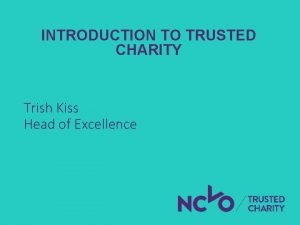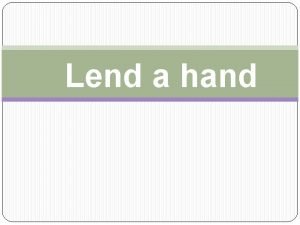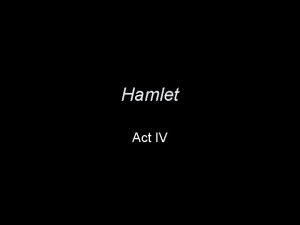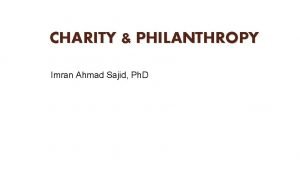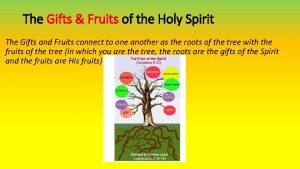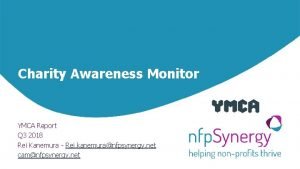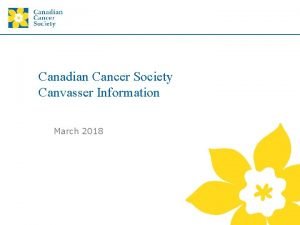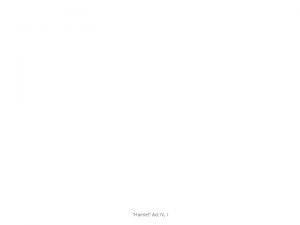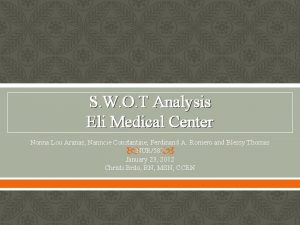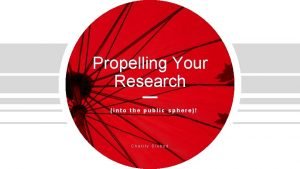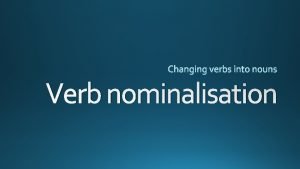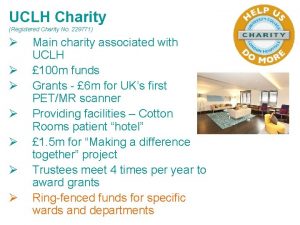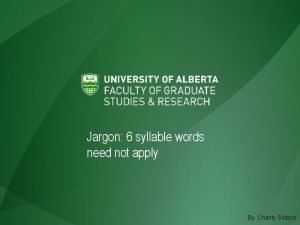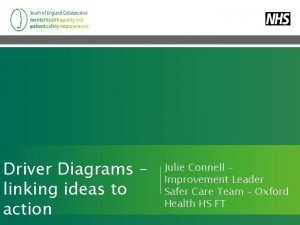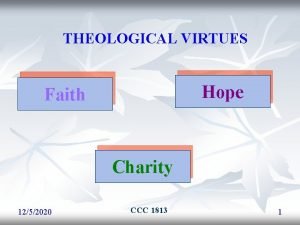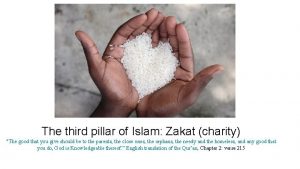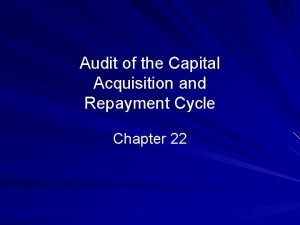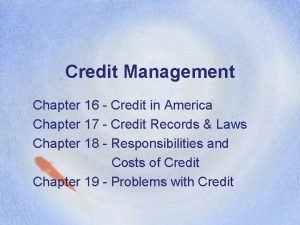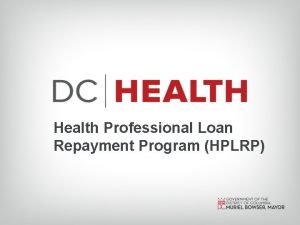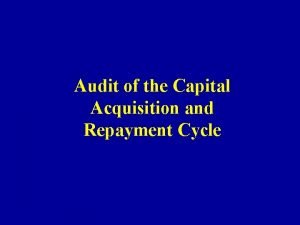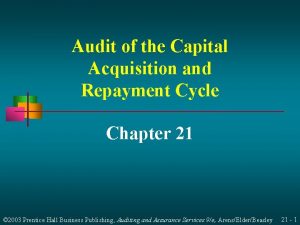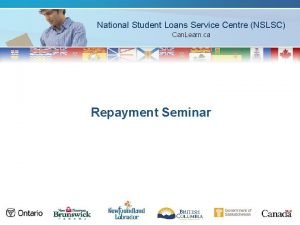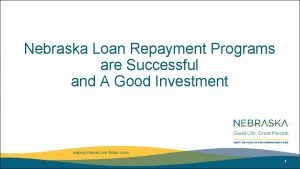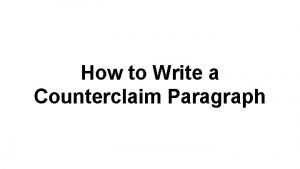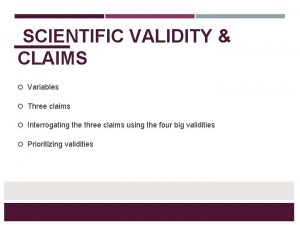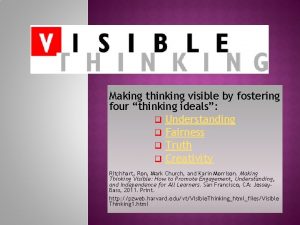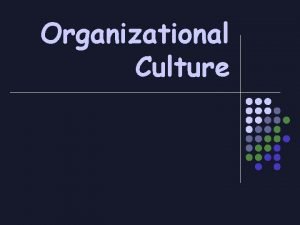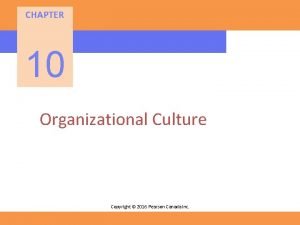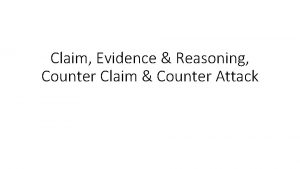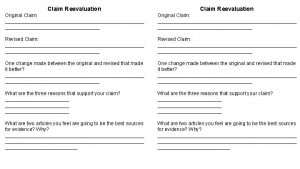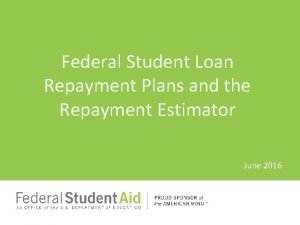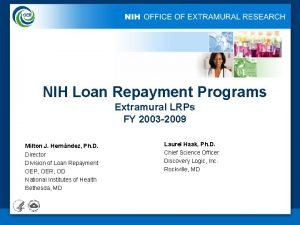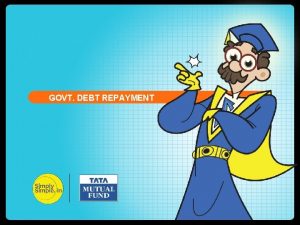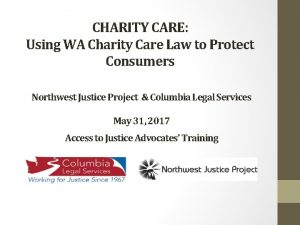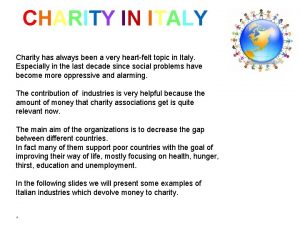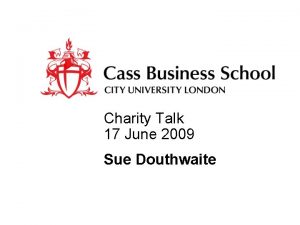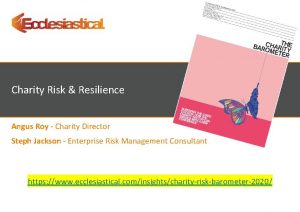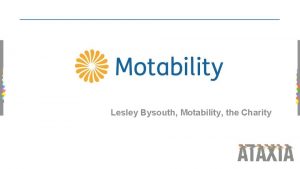Making a Repayment Claim Charity Repayment Claim Options

















































- Slides: 49

Making a Repayment Claim

Charity Repayment Claim Options Option 2 Government Gateway Option 1 Paper Charity Claim form - Ch. R 1 (2013) On line Charity Repayment Service (Up to 1, 000 donors) By post HMRC Data Processing Centre Extracted Claim information From own Laptop or PC Claim data HMRC Charities Protective marking – Unclassified, Protect, Restricted (delete as required) Gift Aid, Other Income & Charity Small Donation scheme schedules Option 3 3 rd. Party Software (OOO’s of donors) | 2

Paper Ch. R 1 Claim Form + Ch. R 1 CS (Continuation sheet) • Only available direct from HMRC • Form will be handwritten, scanned and data extracted • Ch. R 1 - space for 15 Gift Aid donors + 6 Other taxed income items + 2 Community Buildings + 5 Connected charities • Ch. R 1 CS - space for 5 more extra Gift Aid donors • Photocopies not acceptable • Typed schedules & Covering letters not acceptable Protective marking – Unclassified, Protect, Restricted (delete as required) | 3

Charity Repayment Claim Service Introduced in April 2013 • Only charities registered with HMRC can use the Service • Must first register with Government Gateway on line • ID & Activation PIN posted to authorised official - Must activate within’ 28 days • Then need to Register and activate online service • Separate service for Agents that submit claims on behalf of charities Protective marking – Unclassified, Protect, Restricted (delete as required) HMRC NL Standard | 05/08/2013 | 4

Gift Aid Online Schedule Protective marking – Unclassified, Protect, Restricted (delete as required) | 5

Common errors • Wrong reference number quoted • Incorrect authorised official named • Incorrectly complete the regulator details • Hyphen in telephone number • Ticking yes to aggregated donations when donor details have been supplied • Not completing or incorrectly completing the summary page • Exceeding the maximum donation amount for GASDS, at present £ 5000 max • Duplicating amounts in error Protective marking – Unclassified, Protect, Restricted (delete as required) HMRC NL Standard | 05/08/2013 | 6

Protective marking – Unclassified, Protect, Restricted (delete as required)

Protective marking – Unclassified, Protect, Restricted (delete as required)

Protective marking – Unclassified, Protect, Restricted (delete as required)

Protective marking – Unclassified, Protect, Restricted (delete as required)

Protective marking – Unclassified, Protect, Restricted (delete as required)

Protective marking – Unclassified, Protect, Restricted (delete as required)

Protective marking – Unclassified, Protect, Restricted (delete as required)

Protective marking – Unclassified, Protect, Restricted (delete as required)

Protective marking – Unclassified, Protect, Restricted (delete as required)

Protective marking – Unclassified, Protect, Restricted (delete as required)

Protective marking – Unclassified, Protect, Restricted (delete as required)

Protective marking – Unclassified, Protect, Restricted (delete as required)

Protective marking – Unclassified, Protect, Restricted (delete as required)

Protective marking – Unclassified, Protect, Restricted (delete as required)

Protective marking – Unclassified, Protect, Restricted (delete as required)

Protective marking – Unclassified, Protect, Restricted (delete as required)

Protective marking – Unclassified, Protect, Restricted (delete as required)

3 rd party Software route • A data file is created (. xml schema) from a Gift Aid software package • Submitted to HMRC via Government gateway • Format of data is checked (validated) and acceptance of data is acknowledged • Technical Specification is due to be available end of October • Test Service available from November • HMRC Software Developers Support Team (SDST) Protective marking – Unclassified, Protect, Restricted (delete as required) HMRC NL Standard | 05/08/2013 | 24

What to do if you make a mistake? ! • Firstly and most importantly…. . DON’T PANIC!! We understand that mistakes happen and we are here to help! • If you’ve only just submitted your claim and it hasn’t been repaid – phone our Helpline on 0300 123 1073 and they can put a lock on the account - this should prevent payment from going out and we can amend/reject your claim. Protective marking – Unclassified, Protect, Restricted (delete as required) HMRC NL Standard | 05/08/2013 | 25

What to do if you make a mistake? ! If your claim has already been repaid and you then realise you’ve made a mistake, just phone us on 0300 123 1073, or put the information in writing (letter or via the ‘Contact Us’ section of Gov. uk website). You’ll need to let us know the total amount the charity have been overpaid by. We can then either raise a manual charge on the system for the amount the charity have been overpaid by, or advise you to enter an adjustment on your next claim We understand these mistakes do happen though so please don’t worry! Protective marking – Unclassified, Protect, Restricted (delete as required) HMRC NL Standard | 05/08/2013 | 26

Any questions on the Making A Claim?

Gift Aid Small Donations Scheme (GASDS)

Small Charitable Donations Act 2012 (Gift Aid Small Donations Scheme) • From 6 April 2013; Charities & CASCs that receive small cash donations of £ 20 or less will be able to apply for a Gift Aid style repayment without the need to obtain Gift Aid declarations for those donations • GASDS is a public spending initiative (not a repayment of tax) that gives Charities & CASCs a top-up payment on donations they receive • The total amount of small donations was capped at £ 5, 000 maximum per tax year, giving a top-up repayment of £ 1, 250. • This increased to £ 8, 000 maximum per tax year for GASDS collected from 6 April 2016 and the top-up repayment will increase to £ 2, 000 Charities only have 2 years from the end of a tax year to claim a top-up payment on small donations before they go out of date. Protective marking – Unclassified, Protect, Restricted (delete as required) HMRC NL Standard | 05/08/2013 | 29

What is a small donation? • A cash donation of £ 20 or less from an individual • “Cash” means notes or coins of any currency. • Donations must be collected and banked in the UK • Membership Fees not covered by a Gift Aid Declaration cannot be small donations under this scheme • Cash donations from Companies or Trusts cannot be GASDS • No benefits can be given to an individual that makes a small donation (only gifts with negligible value such as a lapel sticker are allowed) Protective marking – Unclassified, Protect, Restricted (delete as required) HMRC NL Standard | 05/08/2013 | 30

The Gift Aid “matching rule” The amount of GASDS top-up charities can claim also depends on the amount of Gift Aid donations that they have received and successfully claimed on in that tax year. The maximum amount of GASDS top up they can claim is 10 times the total amount of Gift Aid donations claimed on by the charity or CASC in that tax year. To claim a top-up payment on £ 8, 000 of small donations a Charity or CASC needs to successfully claim Gift Aid on at least £ 800 of eligible donations in the same tax year. They can only match GASDS donations to Gift Aid donations received in the same tax year. Protective marking – Unclassified, Protect, Restricted (delete as required)

Community buildings What is Community building? A community building is a building (or part of a building) in which a charity carries out its charitable activities to groups of 10 or more beneficiaries on at least 6 occasions each tax year. • The beneficiaries must not be charged for access to the part of the community building where the charitable activity takes place • The charitable activity must also be open to members of the general public (or a section of the public) The beneficiaries do not need to be the same 10 people each time Protective marking – Unclassified, Protect, Restricted (delete as required)

Community Buildings Examples of a Community Buildings are: • A village hall • A cathedral • A town hall • A synagogue • A church • A mosque etc. • A School • A Scout hut Charities do not need to own a building for it to qualify as a community building. A function room of a hotel could be a community building for a support group if the group met there at least 6 times each year to deliver charitable activities to 10 or more beneficiaries, provided the room was used exclusively by the group. Protective marking – Unclassified, Protect, Restricted (delete as required)

Community Buildings A building cannot be a community building if the building (or parts of it) is used wholly or mainly for residential purposes or the sale/supply of goods unless the charity is using part of that building exclusively to carry out a charitable activity. Two or more buildings on the same or adjacent land are treated as a single building where the same person or organisation holds a freehold or leasehold interest in the land Examples of buildings which are not community buildings include: • Priest’s House • Charity Shops • Vicarage / Manse • • A Supermarket Residential care homes Protective marking – Unclassified, Protect, Restricted (delete as required)

Eligibility for claiming GASDS between 6 th April 2013 – 5 th April 2017 • The charity must have been in existence with HMRC for at least 2 full tax years before the year of claim • Must have made successful GA claims in 2 of the previous 4 tax years without a gap in claims of 2 or more years • Charity has not incurred an HMRC penalty in respect of GA or GASDS claims in the previous 2 tax years • GASDS must be claimed within 2 years from the end of the tax year to which the claim relates Why do we have an eligibility criteria? - A good Gift Aid record assures HMRC that charity has appropriate internal processes in place to operate GASDS correctly. Protective marking – Unclassified, Protect, Restricted (delete as required) HMRC NL Standard | 05/08/2013 | 35

Eligibility for claiming GASDS between 6 th April 2013 – 5 th April 2017 (continued) • Donations made by text message or bank transfers are not eligible. • Donations made by credit/debit card are not eligible It isn’t always obvious that a donation is £ 20 or less. E. G. in a church collection an individual could donate £ 30 in three £ 10 notes without the collector realising. Donations will be eligible as long as the managers of the charity/CASC have taken reasonable steps to apply the £ 20 limit. Protective marking – Unclassified, Protect, Restricted (delete as required)

Gift Aid Small Donations collected on or after 6 th April 2017 On 6 April 2017 some of the rules for GASDs changed. Eligibility conditions: • An eligible Charity or Community Amateur Sports Club (CASC) can claim a topup payment on small cash or contactless donations under the Gift Aid Small Donation Scheme (GASDS). • They will need to understand out how much they can claim by reading HMRC’s guidance. Factors that can affect the amount they can claim include: • The basic rate of income tax (Currently 20%) • The total eligible small donations they have collected • Any cap on the amount of small donations they can claim on • How much Gift Aid they have claimed on; the “matching rule” • If the charity or CASC is connected to another charity or CASC Protective marking – Unclassified, Protect, Restricted (delete as required)

Gift Aid Small Donations collected on or after 6 th April 2017 Eligibility conditions (continued): For claims relating to the 2017/18 tax year and later Charities and CASCs no longer need to meet the following requirements before they can make a claim for a top-up payment on eligible small donations: • Charity or CASC must be registered as a CASC or established as a charity for tax purposes for at least the 2 previous complete tax years • Charity or CASC must make a successful Gift Aid claim in at least 2 of the previous 4 tax years, and there must not have been a period of 2 or more consecutive complete tax years between those tax years during which it made no successful Gift Aid claims - in practice this means a Gift Aid claim must be made in at least every other tax year Protective marking – Unclassified, Protect, Restricted (delete as required)

Eligible small donations • The top-up payment is calculated on the amount of eligible small donations your charity or CASC has collected. • Eligible small donations are cash or contactless donations made by an individual to a charity or CASC for £ 20 or less. Donations must be collected in the UK and paid in to a UK bank or building society account kept by the charity. • Gift Aid and GASDS top-up payments cannot be claimed on the same donation. E. G. GASDS should not be claimed if a charity receives a donation from an individual who has completed a valid Gift Aid declaration that covers the donation. • Contactless debit or credit card payments will be an acceptable way of making a small donation. This includes mobile phone Apps or other devices. Protective marking – Unclassified, Protect, Restricted (delete as required)

Community Buildings All churches are a community building it will affect how much you can claim From 6 April 2017 charities can no longer claim a top up payment on donations of up to £ 8, 000 per charity plus an additional £ 8, 000 of small donations collected in each community building they operate from. New rules will apply to all donations collected on or after 6 April 2017. If your charity has only one community building, it should make a GASDS claim on a maximum of £ 8, 000 of eligible small donations each tax year collected anywhere in the UK. Protective marking – Unclassified, Protect, Restricted (delete as required)

Community Buildings If your Parish has 2 or more community buildings: Parishes & PCCs that have 2 or more community buildings should claim: • Up to £ 8, 000 top-up payment for each community building. • This option enables a Parish to claim a GASDS top-up payment on eligible small donations collected in the church & within the same Local Authority area as the community building they are claiming for Protective marking – Unclassified, Protect, Restricted (delete as required)

Community Buildings From 6 April 2017 charities claiming under the community building rules can now collect donations at any time, not just during charitable activities, as long as: • The building qualifies as a community building • The donations are collected in the same Local Authority area as a qualifying community building • The charity claims on a maximum of £ 8, 000 of eligible donations per community building Charities will need to decide which option would be best for each tax year. If a charity changes it’s mind part way through the tax year, then it must notify HMRC before it makes any further top-up claims. Protective marking – Unclassified, Protect, Restricted (delete as required)

“Local Authority Area” “Local authority area” means: • In England, a district council, a county council if there is no district council, a London borough council, the Common Council of the City of London or the Council of the Isles of Scilly If a charity has collected eligible small donations in a Local Authority area where the charity has more than one community building they can choose which building to allocate the donations to. The only exception to this is when donations are collected inside a community building, when they can only allocate these donations to the building they were collected in. Protective marking – Unclassified, Protect, Restricted (delete as required)

“Local Authority Area” (continued) Example - A charity has 3 community buildings in a Local Authority area. During the tax year the charity collected £ 15, 000 in eligible small donations inside this Local Authority Area. £ 4, 000 was collected inside of one community building and therefore the charity can only allocate the £ 4, 000 to that particular building. The remaining £ 11, 000 was collected outside of the community buildings and can be allocated to the 3 buildings in any way the charity chooses, as long as the amount allocated to each community building does not exceed £ 8, 000. Protective marking – Unclassified, Protect, Restricted (delete as required)

Record Keeping For contactless donations charities need to keep records that identify how much was collected on each terminal so that they can work out how much was collected in a particular Local Authority area. They must keep a record of the denomination of all notes received (£ 5, £ 10, £ 20) and exclude all £ 50 notes Small cash donations must be banked if the charity or CASC wants to claim a GASDS top-up. If the charity or CASC uses small cash donations to pay for minor expenses, it will only be able to claim on the net amount banked Some charities provide fundraisers with paying in slips so that they can pay any amounts collected directly into the charity account. The counterfoil receipt which notes the breakdown of the coins and notes collected should then be given to the charity for audit purposes. Protective marking – Unclassified, Protect, Restricted (delete as required)

Record Keeping (continued) If a charity wants to claim GASDS top up payments based on amounts collected in a Local Authority Area near a community building they must also keep a record of: • The address of the community building and a record to show that the building held at least 6 charitable activities for 10 or more beneficiaries to qualify as a community building • The date(s) that the money was collected • The location(s) that the money was collected - this should include full address and postcode • Which community building the donations will be allocated to for the purposes of the GASDS claim Protective marking – Unclassified, Protect, Restricted (delete as required)

Any questions on GASDS?

Need more information? Protective marking – Unclassified, Protect, Restricted (delete as required) | 48

Thank you Website: WWW. GOV. UK Helpline: 0300 123 1073 E-mail: repaymentqueries. charities@hmrc. gsi. gov. uk steven. carroll@hmrc. gsi. gov. uk
 Value of claim example
Value of claim example Trish kiss
Trish kiss Opal charity
Opal charity Missionaries of charity kolkata
Missionaries of charity kolkata Charity retail association
Charity retail association Charity reading
Charity reading Basis point charity
Basis point charity Caritas romana rubens
Caritas romana rubens Fill in burst senior charity
Fill in burst senior charity By gis and by saint charity
By gis and by saint charity Indiana gaming commission charity gaming division
Indiana gaming commission charity gaming division St vincent de paul facts
St vincent de paul facts Twin-track approach
Twin-track approach At 7
At 7 Charity fruit of the holy spirit
Charity fruit of the holy spirit Reid anderson liverpool
Reid anderson liverpool Charity awareness monitor
Charity awareness monitor Charity canvassing canada
Charity canvassing canada I dare damnation
I dare damnation Makati medical center charity program
Makati medical center charity program Charity slobod
Charity slobod Charity verb
Charity verb Cotton rooms uclh
Cotton rooms uclh Charity slobod
Charity slobod Charity ideas
Charity ideas Asha daan byculla
Asha daan byculla Ssvp scotland
Ssvp scotland Tujuan charity
Tujuan charity Charity reading
Charity reading In the shade of my charity
In the shade of my charity Ccc 1813
Ccc 1813 Third pillar of islam
Third pillar of islam Capital acquisition and repayment cycle
Capital acquisition and repayment cycle Property pledged to assure repayment of a loan
Property pledged to assure repayment of a loan Hplrp
Hplrp Audit of capital acquisition and repayment cycle pdf
Audit of capital acquisition and repayment cycle pdf Capital acquisition and repayment cycle
Capital acquisition and repayment cycle Nslsc login online
Nslsc login online Rumus dor doi dop
Rumus dor doi dop Nebraska loan repayment program
Nebraska loan repayment program Trade offers loans
Trade offers loans What is inferring
What is inferring War making and state making as organized crime summary
War making and state making as organized crime summary Claim definition persuasive writing
Claim definition persuasive writing Counter claim example
Counter claim example Association claim
Association claim Creative hunt thinking routine
Creative hunt thinking routine Entry socialization options
Entry socialization options Wan osi layer
Wan osi layer Entry socialization options
Entry socialization options

